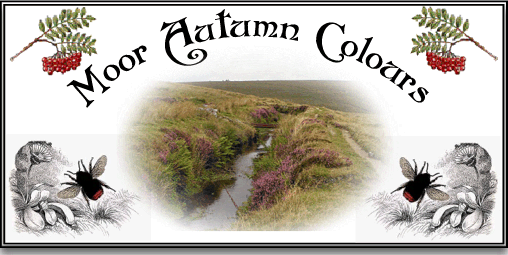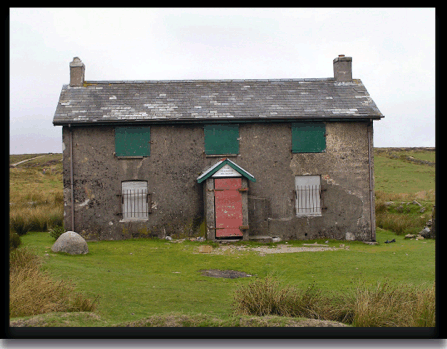
I needed several photos for the website which involved travelling around the moor and the day didn’t bode well. The first place I needed to go was Nun’s Cross and I found Princetown cloaked with fog and clogged with visitors. However, by the time I reached Whiteworks there were tiny patches of blue peeping through the grey skies. I also wanted a picture of a dipper and I knew I had seen some along the Devonport leat so that was the route I took to Nun’s Cross. I hadn’t been along here for years and was amazed at how the vegetation along the leat banks had grown. Today it was as if the waterway had been lined in purple, on both sides clumps of heather mingled with verdant green ferns and weeds – see ill. 1 here. Suddenly a large clump of heather exploded as two mallard ducks clattered into the air, quacking with indignation at being disturbed. A little further ‘downleat’ a small yellow wagtail bobbed up and down on a midstream boulder, frustratingly enough it just seemed to stay long enough to get it in the viewfinder before flitting off. In places the whole surface of the leat was studded with tiny skaters, it was as if it was their Devonport Regatta Day with flotillas of them tacking across the water – see ill. 2 here. The next heart-stopping encounter was with two snipe as they too shot up from the leat, ‘cheeking’ loudly as their white tipped wings zig-zagged out across the moor. Out on the edge of Foxtor Mire a herd of cattle grazed contentedly against the cloud streaked shadows scudding across the flank of far off Ter Hill – see ill. 3 here. Looking back the curving leat seemed to lure the eyes towards Whiteworks before veering of sharply to the left, again the perfectly matched colour scheme of mauve and green giving a nice foreground to the view – see ill. 4 here. It didn’t take long to reach the old farmhouse which defiantly stands in this remote, windblown spot of Dartmoor. The place has a weird appearance, the green shutters clashing alarmingly with the weather beaten red door, the building could be something straight out of a horror story. There is a hand written sign over the door which says, “to use thing bunkhouse ring …”, a great example of minimalist advertising.

Nun’s Cross Farm
I was really surprised as to how much the old cross had changed since my last visit, the various inscriptions are now virtually un-readable due to the heavy crust of mosses and lichens. It was here that the low battery warning on the camera started flashing which is typical as the whole purpose of coming here was to take some photographs of the cross. Gingerly I clicked away, expecting at any moment to hear the beep as the batteries quietly passed away, for once it never came – bonus. Below the farm a herd of pie-bald ponies were grazing amongst the heather, their brown and white coats contrasting nicely with the delicate purple of the heather – see ill. 5 here. There is/was a stone built into one of the old farm walls that had a coat of arms engraved on it, I have a photo of it but wanted a more recent one, but for the life of me I couldn’t find it. Whether it has been stolen or just lost in the jungle of reeds and vegetation that now encompasses the wall I know not, just that I could see no sign of it. Still, mustn’t complain, the weather was a lot better than I had imagined and I had obtained my photos of Nun’s Cross.
The next port of call was the Ringastan or Ring of Stones on the edge of Soussons, here I wanted some more pictures of the ancient stone circle. Cator Common was a riot of colours ranging from deep rowan red to gorse custard yellow with the odd splash of heather jam mauve throw in for good measure – see ill. 6 here. The stone circle was also hemmed with a mauve foreground of heather which seemed to make to stones look unusually large – see ill. 7 here. As usual the central kistvaen had served as a fire place and was full of black ash and half burnt sticks. I really would love to know what goes on here, are the fires some part of a mystic ritual or just a quirky setting for a barbeque? What I do know is that the resident fly population were particularly aggressive with squadrons of them buzzing and bombing around my head. Recently I read on some website that the explanation for the flies was that they are a plague sent by the spirits of the ancients in retribution for the desecration of their sacred site; namely the fires and whatever else occurs here. Today there was a rather splendid view across the common towards Riddon Ridge, again the autumn hues adding an extra splash of colour – see ill 8. here. I returned to the car with my fighter squadron escort of flies to discover that I had left all the windows wide open and the inside was filled with a swarm of angry flies – brilliant! This then meant a 97mph drive down the road with the windows open and the slipstream sucking the plague of pestilence back out of the car, it got a bit tricky when I tried to take the cattle-grid and bend at such a rate. I’ll tell you, there is nothing that gets on my tripe more than a fly buzzing around whilst I am driving, I take this as a personal affront and will not rest until its been dispatched, either out of the window at its own volition or under my thumb in a mess of guts and gore – what’s the last thing to go through a fly’s’ mind when it hits your windscreen? – its backside.
I also needed a photo of the bracken infestation on Challacombe so from Soussons I moved up towards Grimspound. ‘Twas a journey of dodge the grockle as they hurtled along the middle of the road petrified that a fern frond should scrape along their bodywork. Over the years I have learnt that when you meet a visitor in a narrow lane it is quicker to reverse 12 miles backwards than to wait for them to weave 20 yards in the direction whence they came. I remember a few years back I was not in the best of moods and met a mini load of nuns on the Broadaford road. The driver had to reverse about 10 yards and I would have had to go back about 300 yards. Despite frantic pointing to the passing space the holy sister was having none of it, we sat there 19 minutes until she finally relented. I know that was totally inexcusable and was probably the reason why I had a puncture shortly afterwards, divine retribution I hear you say, no the nun threw a handful of nails as she passed. Now, where was I? Oh yes, bracken and Challacombe, I took the required photo, and one of the view back down the valley – see ill. 10 here. Again, all the hedgerow trees and bushes were weeping and wailing as they bent beneath the weight of their berry crops, the hawthorn, see ill 9 here, and the rowan, see ill. 11 here, serve as excellent examples of the good growing year we have had.
So as always with Dartmoor, no matter how grey and miserable the weather it always finds some colour to brighten up the scenery. This time of year is the final swansong of mauves, yellows, and greens before the colder weather turns everything to a tan brown of winter bleakness.
 Legendary Dartmoor The many aspects past and present of Dartmoor
Legendary Dartmoor The many aspects past and present of Dartmoor
